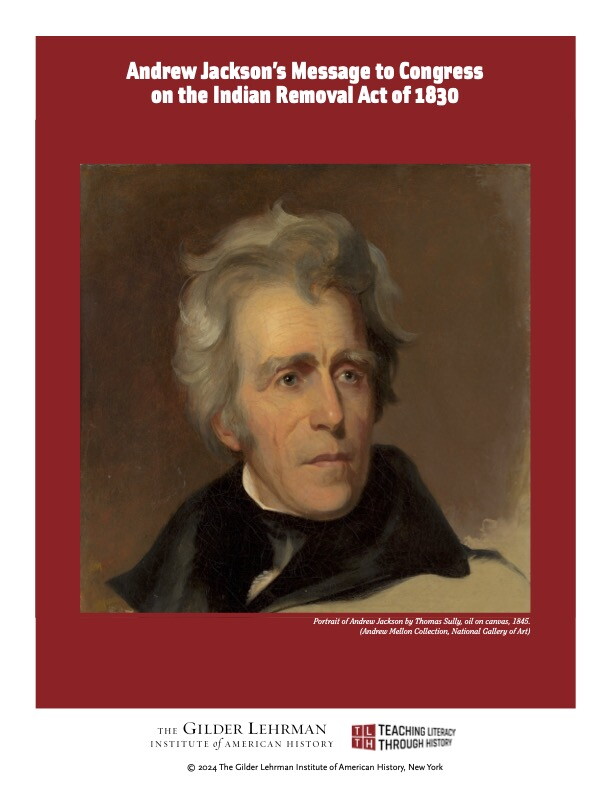Lesson by Tim Bailey
Essay by Lisa Andersen, The Gilder Lehrman Institute and Fordham University
Grade Level: 7–12
Number of Class Periods: 3–5
Primary Era: National Expansion and Reform, 1815–1860
This summer, enroll in graduate-level courses in American history. Apply now!
★ ★ ★Learn about GLI's Annual Gala on Monday, May 12 and purchase tickets.
Grade Level: 7–12
Number of Class Periods: 3–5
Primary Era: National Expansion and Reform, 1815–1860

Over the course of five lessons the students will read, analyze, and gain a clear understanding of Andrew Jackson’s Annual Message to Congress addressing the Indian Removal Act of 1830. The first four lessons require students to read excerpts from the message “like a detective.” Employing summary organizers, practice, review, and discussion, they will master the technique of identifying keywords, creating summaries of excerpts and, as an assessment in the final lesson, writing an argumentative essay.
Lesson Plan Authors: Tim Bailey
Historical Background Essay by: Lisa Andersen, The Gilder Lehrman Institute and Fordham University
CCSS.ELA-LITERACY.RH.6-8.1: Cite specific textual evidence to support analysis of primary and secondary sources.
CCSS.ELA-LITERACY.RH.6-8.6: Identify aspects of a text that reveal an author’s point of view or purpose (e.g., loaded language, inclusion or avoidance of particular facts).
CCSS.ELA-LITERACY.RH.6-8.8: Distinguish among fact, opinion, and reasoned judgment in a text.
CCSS.ELA-LITERACY.RH.9-10.2: Determine the central ideas or information of a primary or secondary source; provide an accurate summary of how key events or ideas develop over the course of the text.
CCSS.ELA-LITERACY.RH.9-10.4: Determine the meaning of words and phrases as they are used in a text, including vocabulary describing political, social, or economic aspects of history/social studies.
CCSS.ELA-LITERACY.RH.9-10.8: Assess the extent to which the reasoning and evidence in a text support the author’s claims.
CCSS.ELA-LITERACY.W.9-10.1: Write arguments to support claims in an analysis of substantive topics or texts, using valid reasoning and relevant and sufficient evidence.
CCSS.ELA-LITERACY.SL.9-10.1: Initiate and participate effectively in a range of collaborative discussions (one-on-one, in groups, and teacher-led) with diverse partners on grades 9-10 topics, texts, and issues, building on others’ ideas and expressing their own clearly and persuasively
How did Andrew Jackson justify a policy of removing Indigenous peoples from their land?
What compensation for Indigenous peoples did Andrew Jackson argue was fair and appropriate?
How did Andrew Jackson describe Indigenous peoples?
Whose interests did Indian removal policy best serve?
Excerpts from President Andrew Jackson’s Annual Message to Congress, December 6, 1830
Learn how the Institute impacts history education through our work guiding teachers, energizing students, and supporting research.